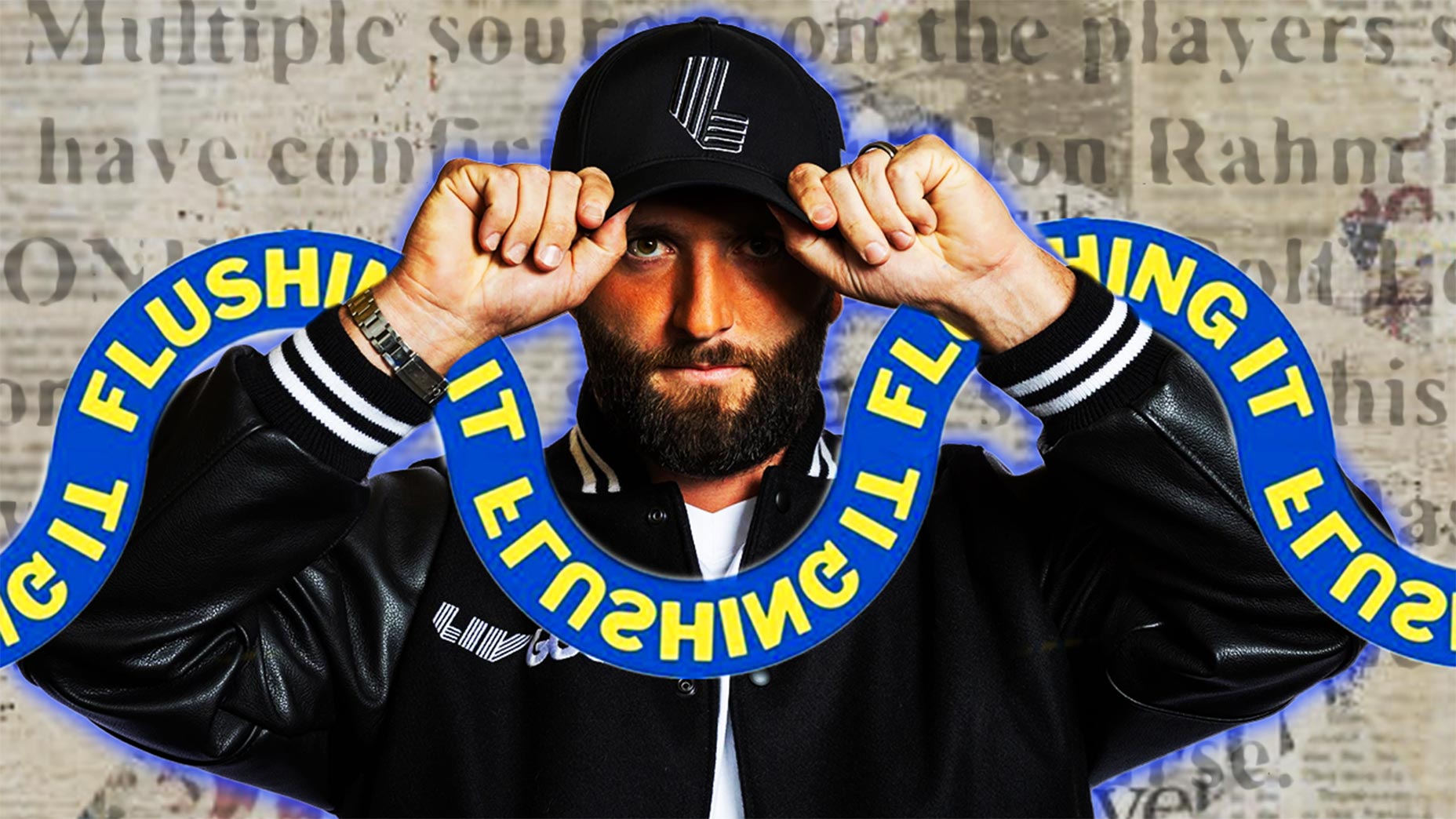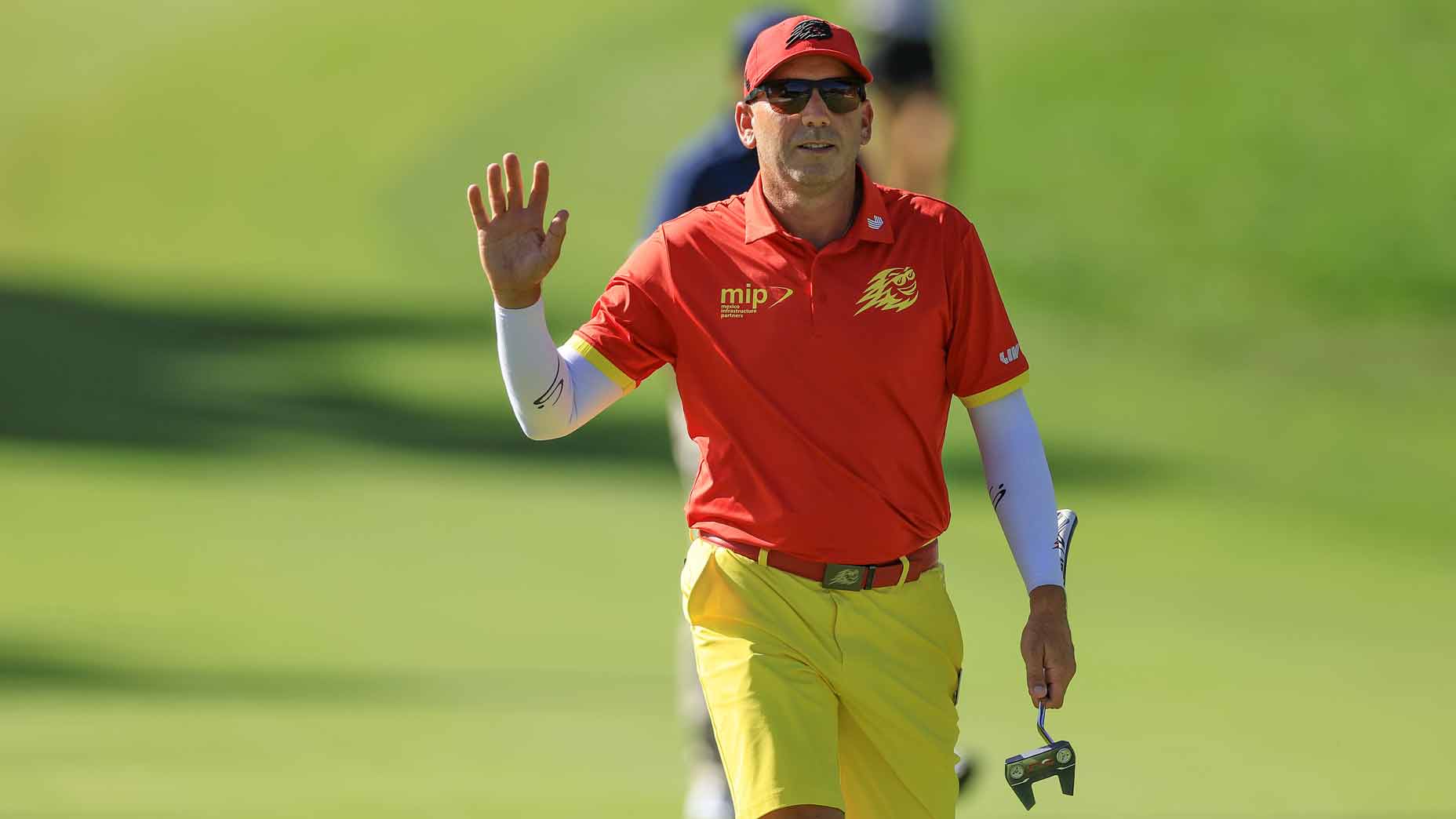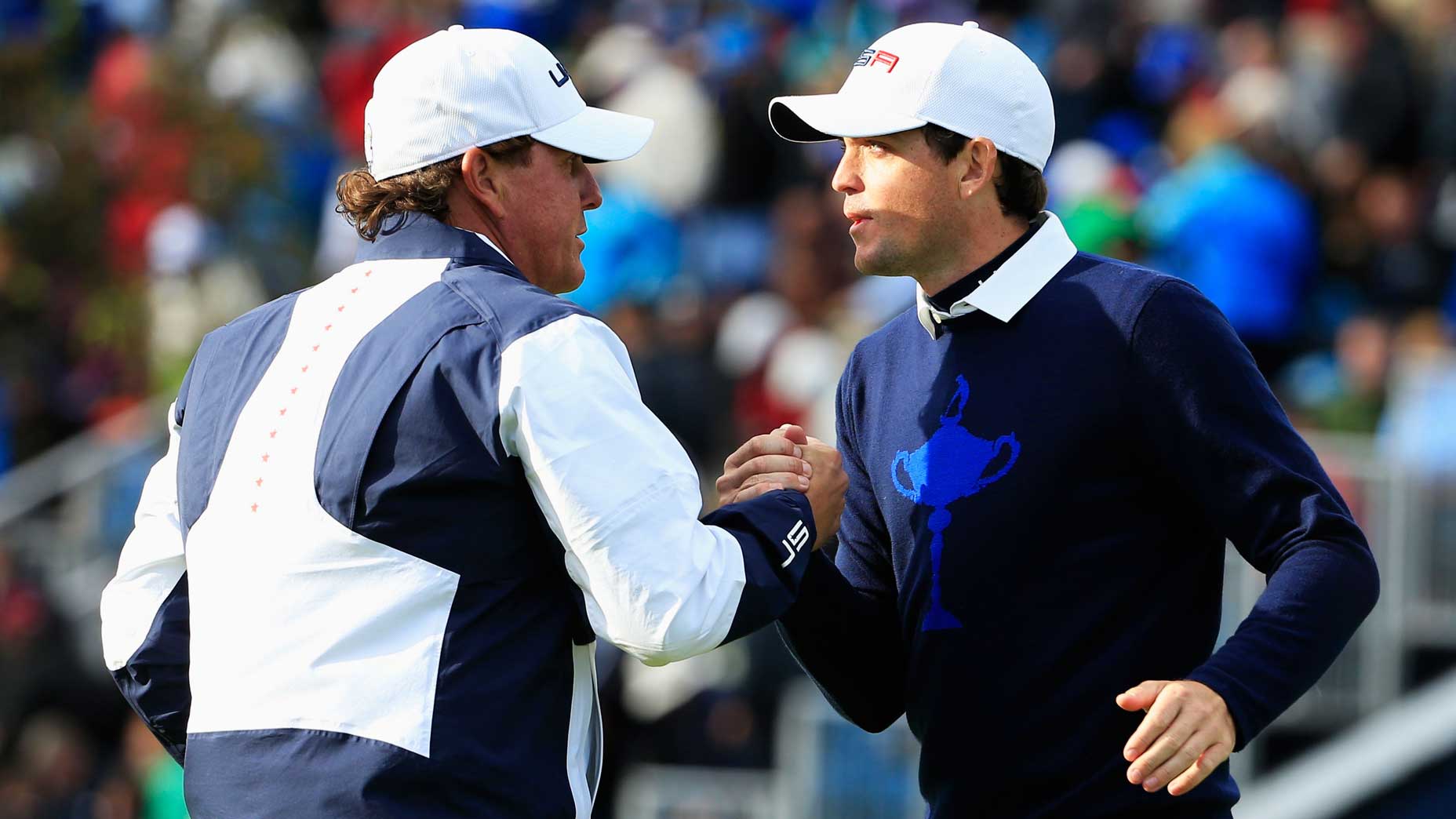The curious case of the club pro who broke the stunning Jon Rahm LIV news

Jon Rahm's LIV Golf departure came as a shock. So did the account, Flushing It, who broke it.
Photo Illustration: Emma Devine; Image: LIV Golf
He had never imagined himself involved in a story that would change professional sports, but Tom Hobbs didn’t need a journalism degree to know he was holding a stick of dynamite. He’d spent days chasing the story, and now, on the last evening of November 2023, he had it confirmed.
Hobbs drafted the post and stared at the screen, reviewing for the first time the report that would ignite the golf world. Then he lit the fuse.
A few seconds later, Hobbs’ words flashed back at him, now live on X for his 45,000 followers — and soon, millions more — to see.
“Multiple sources on the players (sic) side have confirmed,” Hobbs wrote under his social media pseudonym, Flushing It Golf. “Jon Rahm is a DONE deal to the LIV Golf League.”
It was a week before Hobbs’ scoop became official. On Dec. 6, Rahm appeared on the 6 p.m. hour of Fox News in a black letterman jacket and confirmed the unthinkable: He had joined LIV. Back in southern England, Hobbs couldn’t help a grin. After weathering days of second-guessing and name-calling from the internet, including from professional journalists, the fan account Hobbs had started two years earlier “primarily to post stupid golf memes” had broken the golf story of the year.
“It wasn’t just loads of players who were following me [after the story broke], but lots of, like, respected journalists,” Hobbs tells me now. “I never thought those people would care about my opinion. No one knows who the hell I am, and suddenly I’m breaking the biggest news story in golf.”
As Hobbs recalls his Rahm scoop, he’s still incredulous. Even weeks later, he remains perplexed by the whole ordeal. How did a former club pro with a fan account beat out a legion of sports journalists (this author included) for one of golf’s biggest scoops?
What does it say about him? And what does it say about the larger media landscape?
The story of Tom Hobbs, citizen newsbreaker, begins with an attempt at falling in love again.
A decade ago, Hobbs joined the teaching staff at Stoneham Golf Club in Southampton, where he was a stick and regular tournament player. Teaching earned Hobbs an informal introduction to the pro game — where he forged friendships with a group of fringe pro golfers, including fellow Stoneham member (and early LIV defector) Richard Bland. About a decade ago, Hobbs left the sport to become an interior design specialist, and soon he found that he had drifted away from golf. In 2021, he created Flushing It in the hope that it would help him reconnect with the game after he found success with a similar “fan” account for his favorite football club, Southampton. He spent most of the account’s first year in existence posting harmless memes to an audience of a few hundred followers, but then the calendar flipped to 2022.
When LIV arrived, Hobbs felt there was more to the story than money and public outrage. He’d played alongside many of the pros who would be benefiting from the new league and its investment in the Asian Tour, and he felt the Saudi money was helping them. In early 2022 he began posting regularly in support of LIV, and soon realized he’d struck a chord with a subsection of the golf audience disillusioned with the golf “establishment” — particularly those at traditional media outlets — for behavior those fans perceived as unfairly dismissive toward the new league. In what has become a reliable scheme in the social media playbook, the louder and angrier Hobbs tweeted about LIV, the more attention his posts received, and the larger his audience grew. Before long, Flushing It had earned more than 40,000 followers across two platforms, and its founder was invited to attend LIV’s first event, in June 2022, at the Centurion Club in London as a member of the credentialed press.
Flushing It calls itself “fan media,” a descriptor that proves impressively difficult to define. Yes, there are the oxymoronic qualities of the words “fan” and “media,” but Hobbs’ account undoubtedly includes characteristics of each. On one hand, Flushing It proudly remains one of the loudest pro-LIV voices on the golf internet, eschewing traditional journalistic values of nonpartisanship and objectivity in favor of regular support of the league. On the other, Flushing It participates in legitimate “media” functions fairly regularly: aggregating stories, providing “live updates” and, in the case of Rahm’s defection, breaking real news.
Matters of the English language as it relates to an internet personality feel especially trivial, but here they are quite important. To Hobbs, it seems the difference between journalism and “fan media” comes down to gravity. Those who practice journalism ask critical questions and attempt to assail the truth, he says, while those who practice “fan media” shoot from the hip and offer their opinions.
“People don’t necessarily want to hear this straight-down-the-middle story all the time that’s got loads of quotes from various sources,” Hobbs says. “They just want to know this is what’s going on, this is my opinion on it. It’s a bit more fun, and a bit of entertainment as well, rather than just straight-down-the-middle reporting.”
In theory, the motives of both parties are the same — to frame the discussion around golf — but there are reasons why the “fan media” enjoys a healthy dose of skepticism from the public: Its efforts at framing the discussion are not always virtuous.
“There’s content and then there’s journalism,” says Aileen Gallagher, chair of news and online journalism at Syracuse University. “If you’re a content creator, I have no idea what the origins of the piece of content are — Who’s responsible for making it? Whose point of view am I looking at? What points of view are missing? It’s really hard for audiences to critically evaluate the content they’re looking at when they don’t know who the creator is.”
Critical evaluation is even harder when some members of the “fan media” actively serve to undermine the truth. When LIV came online in 2022, the internet flooded with LIV “fan” pages that had ties to fringe political groups and behaved suspiciously like bots. That’s not to say LIV is without fans on social media. Just that since LIV’s inception, a loud subsection of accounts have peddled misinformation, stoked controversy and trolled joyously on behalf of the rival league, forming a new golf social-media institution whose raison d’etre appears to be the insubstantial yet no-less-contemptible parasitic bloodlust of a mosquito.
Beyond fueling media distrust and stoking outrage, these accounts have unintentionally served to undermine the league itself. Credibility is built upon the existence of proof over time, and so even though Hobbs’ report spread rapidly on social media (and was correct!), his proximity to others in the “fan media” space meant that his tweet wasn’t credited as anything more than a rumor for more than a week. On the day the story materialized, the Wall Street Journal was credited for “breaking” the news, not Hobbs. To see the gap in perception, one needed to look only at the metrics: Flushing It’s Nov. 30 Rahm scoop on X earned about 1,200 likes, while Bleacher Report’s repurposing on Dec. 6 earned more than 10,000. (The extent to which the lavatory-adjacent nature of the “Flushing It” name also contributed to public skepticism of Hobbs’ report is, the author admits, unknowable.)
This grates Hobbs, who feels his account is markedly more reputable than other “fan media” accounts, despite their occasional similarities in tone, presentation and opinion. He unequivocally denies that he is on the LIV payroll, as he and other LIV fan accounts are regularly accused — and he doesn’t think he deserves to face those accusations so often.
“I was labeled a ‘LIV bot’ last year because I was positive when no one else was … [pause] and I was a bit controversial … [longer pause] and contrarian,” Hobbs says. “I think it’s slowly progressing that a lot more people are starting to understand that I do have an inside line for a lot of people in the game.”
This checks out: Hobbs maintains friendships with several pros and influential LIV figures and converses with a network of sources inside the league semi-regularly. He is tapped into the slipstream of LIV rumors and gossip more than most in the media ranks.
Of course, some of the reason for this access could be because Hobbs is not in the media ranks. There is little question that the anti-media sentiment among many of LIV’s followers has bled into the league’s upper echelons, particularly the playing class, which has contributed to a steady flow of sensitive information between the league and some within the “fan media.” There’s nothing inherently wrong with this: The democratization of information in the social media age means stakeholders are not beholden to the traditional press and are liberated to share information with whomever they please. But when information is shared devoid of necessary context or nuance, the public risks misunderstanding the bigger picture.
On the day he broke the Rahm story, Hobbs had done his due diligence: leveraging sources for information and confirming that information with other sources, just as traditional journalists do. His intel was right, and it was first.
“I think that everybody knew [the Rahm signing] was happening,” he says. “But [the journalists] needed nailed-down proof, whereas I don’t have to quote sources and stuff. I could get proof from people without risking their — what’s the word? — anonymity.”
Sure, Hobbs might have been bending the rules of attribution — under which a source is supposed to enjoy the privilege of anonymity only when it is deemed absolutely necessary — but that’s a slap-on-the-wrist offense when it comes to reporting information as sensitive as Rahm’s signing with LIV on the eve of a negotiation deadline with the PGA Tour.
As we talk for longer, though, it becomes clear that we have a difference of opinion. Hobbs pushes back hard against my relatively democratic use of the word “journalist” to describe his work, and he disagrees with my suggestion that the only true barrier to good journalism is the thoughtfulness and accuracy of the person delivering it, not their credentials.
“I don’t see myself as a journalist,” he says. “Some people have said that I am, but I don’t really see it as that. I see it as fan media.”
If not journalism, then what, exactly, would he consider the Rahm scoop to be?
He pauses.
“There was never any intention to [break the news], but just like everything with Flushing It, it’s just sorta happened,” he says. “It’s all about being in the right place at the right time.”
This type of information-sharing is hardly restricted to golf; it’s the reality of life on the internet, particularly on X, where anyone’s ability to buy a blue checkmark upended the traditional hierarchy that sorted the notable and trustworthy voices from everyone else. That has democratized the way we acquire and understand information. But it also has shifted the burden onto the audience to sift through news vs. humor vs. speculation vs. parody vs. anything else.
It is here that Hobbs seems to define his particular brand of “fan media” in the clearest way yet: information without stakes. Hobbs’ financial attachment to Flushing It is minimal; he said he turned down an offer last year to turn the account into a full-time business. That independence affords him significant freedom to share information without fear of the personally ruinous downsides of being wrong — freedom not possessed by journalists with reputations and families and mortgages. In the case of breaking news, that is a considerable advantage. But in the case of his perceived trustworthiness, it is not.
“I don’t see myself in a journalist type of role, because then it becomes very serious, and you kind of have to start using these players, who I just enjoy being friends with,” Hobbs tells me. “It becomes a whole different game.”
Hobbs is a gifted rhetorician, but his unwillingness to acknowledge the seriousness of the jump he’s taken from “fan media” to “news breaker” underscores why he’s frustrated by his public perception. If he won’t call himself trustworthy, why should anyone else?
“It’s the rise of the culture of the fan,” says Gallagher, the Syracuse professor. “What’s dangerous about it is that if you’re a creator, you usually don’t have any obligation to your audience. Your obligation is to yourself, so you’re going to be making decisions that benefit yourself, and not your audience.”
Why spend so much time harping on self-identity? After all, in the case of the Rahm news, Hobbs was trustworthy. Because what Hobbs calls himself — be it a journalist or “fan media” or a content creator or a zebra — matters. It matters because “the truth” often is a matter of perception, and that depends upon the person telling it. (Think about how many times you’ve seen a firing referred to as a “parting of ways,” or a politician resigning to “spend more time with his family.” Those are one version of the truth, but are they the absolute truth?)
Hobbs is correct in distinguishing his methods from “real” journalism, but he is wrong to think himself incapable of making the jump. In some ways, he admits, he has started to do it already. He has intentionally “toned down” the rhetoric on Flushing It as the account has grown its profile, and he recently refocused his strategy on serving as a “neutral voice for the fans.” After building a golf social-media monolith by taking aim at the establishment, Flushing It is now trying to avoid stepping on landmines (with the exception, Hobbs admits, of his posts on a few regrettable “really drunken nights”). He even recently criticized LIV, a first in this author’s accounting, for what he perceived as growth failures in the league’s first two years.
“I feel there’s a responsibility now because it’s getting to be such a big audience,” he said. “I have to treat it as though I’m a public figure now, really, because there are so many eyeballs on the account.”
Flushing It may never be a pillar of the Fourth Estate, but the message at the end of Hobbs’ anti-establishment-to-establishment story is important: It’s the people who matter.
The “responsibility” of life in the public eye is as much a matter of journalistic integrity as it is one of human nature. Most people want to be well-liked and well-regarded — despite the worst inclinations of the insipid, shouting-into-the-void nature of social media — and at the simplest level, being well-liked and well-regarded involves acting in a manner deserving of it. That tact might not produce as many followers, but how valuable is an audience if you’ve trained them not to believe you?
There is a world where “fan media” can exist alongside traditional journalism — we’re living in it. That sounds messy, but it doesn’t have to be. As it turns out, the responsibilities of this world might not be all that different from the ones that came before it.
“It’s kind of scary,” Hobbs says. “But I have to accept that I now have a role where I am part of golf media, even though it’s not established golf media.”
“It’s a different kind of media … a new kind of media.”
The author (cautiously) welcomes your thoughts at james.colgan@golf.com













